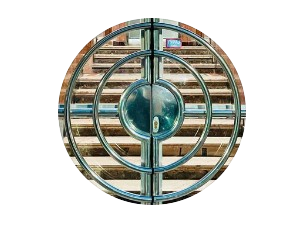
On this route, we will explore the oldest districts of Belgrade – Kosančićev Venac and Dorćol. Today, both of these districts belong to the municipality of Stari Grad.
Kosančićev Venac is a part of the city and a street in Belgrade named after the legendary Serbian medieval hero Ivan Kosančić. The nearby streets Obilićev Venac and Topličina Venac are named after his military companions and friends from the Battle of Kosovo, Miloš Obilić and Milan Toplica. The term "venac" in the names of these streets refers to a "wreath" due to their radial layout. The architecture of the 19th century is well-preserved in this area. Old houses, their facades, as well as cobblestone streets, have recently been reconstructed. Rows of trees and lanterns that match the spirit of Kosančić's Venac at the time of its foundation have also been restored.
The city center has always been located in the area of today's Dorćol, even since the times of ancient Singidunum. The name Dorćol itself means the intersection of four streets (from Turkish, dort - four, yol - road) and refers to the intersection of today's streets Čarа Dušаna and Kralja Petra. During the Turkish rule, the main trading street in Belgrade was today's Kralja Petra Street. When the Austrians conquered Belgrade in the early 18th century, they began transforming the then Turkish village into a modern Western city, with Dorćol undergoing the most significant changes.



We begin our route on the main pedestrian street of the city - Kneza Mihaila. The emergence and development of the street is associated mainly with two personalities - Prince Mihailo Obrenovic, who advocated the Europeanization of Belgrade, and Emilian Josimovic, who developed the first urban plan for Belgrade in 1867. Every building on this street is significant either because of its architectural value, or because of the individuals who built them or lived in them, or because of the events that took place in them, or because of the institutions that functioned in them.
In the building at number 22, there is currently the Indigo Hotel. The hotel was opened in 2021 and consists of two restored buildings from the 19th and 20th centuries. Through the luxurious Art Nouveau entrance group, you will enter a cozy atrium adorned with murals.






The building was constructed in 1889 as a two-story residential and commercial building. The Spasićs lived on the ground floor, and the second floor was rented to one of Belgrade's most famous residents. The overall stylistic concept of the building featured an unusual combination of two architectural expressions: a harmonious form of Italian Renaissance architecture, skillfully enriched by a decorative roof whose origins go back to the French Renaissance. The entrance from Knez Mikhailova street is especially decorative, with a corridor divided by shallow pilasters, richly decorated capitals, between which are depicted landscapes and medallions with female busts.



Milan Antonovic was an innovator and brought modernist features to the architecture of Belgrade, which at the beginning of the century bore a distinct stamp of oriental and academic style. The corridor of the building was painted by the famous decorative artist Dragutin Inkiostri, who can be considered the first interior designer in Serbia. Besides allegories and art-nouveau patterns, he also included landscapes of Venice and Dubrovnik. You can also admire his works in the house of the Vuk Foundation at Kralja Milana and in the house of Jovan Cvijić in Kopitareva gradina.



Thanks to the reputation that Jakov Čelebonović had in the society of interwar Belgrade as a lawyer and the president of the Jewish Community, the house was a favorite meeting place for prominent people of that time. Jakov and Johanna Čelebonović had six children, of whom Marko and Aleksa held a special place in Serbian culture and art. Marko Čelebonović is one of the most important Serbian artists of the 20th century, and Aleksa Čelebonović is a distinguished art historian, university professor, and art critic.
Since 1950, the building has housed the Museum of Applied Arts.



The Belgrade Cooperative for Mutual Aid and Savings was founded in 1882 on the initiative of a group of Belgrade merchants with the aim of providing members of the middle class with access to favorable loans and financing economic activities. The cooperative moved into the building immediately after its completion in 1907 and remained there until its dissolution. At that time, shops were located on the ground floor of the side wings, while administrative and managerial offices were on the second and third floors. One wing housed the banking department, and the other housed the insurance department. Later, the building came under the ownership of the Geological and Geophysical Institute "Jovan Žujović," which is why Belgraders often refer to it as the "Geozavod."
The social significance of the Belgrade Cooperative determined monumentality as the only possible architectural concept. The building is a blend of different styles with an academic foundation in the Neo-Baroque style and elements of Art Nouveau. Each decorative element, wall and ceiling paintings, sculptures, molding, chandeliers, or wall appliqués, painted glass parapets in the cash hall, glass surfaces, and doors of the grand hall, attest to the uniqueness and "synthesis of the arts," which led to the designation of the Cooperative building as a monument of cultural significance.
The building underwent reconstruction in 2014. Currently, it houses the headquarters of "Belgrade on Water" and one of the most luxurious restaurants in the city, "Salon 1905."



From an architectural standpoint, the building is executed in a very modern for that time Art Deco style. The official entrance through the circular and oval hall, adorned with a luxurious spiral staircase and wrought-iron balustrade, is illuminated by stained glass and a skylight. The creation of the stained glass on the main staircase depicting 'Daedalus and Icarus' was entrusted to the artist Vasa Pomorišac. The large and small salons are decorated in English style, the hall and two 'winter gardens' (enclosed cabins) in the French style of Louis XVI, while the bar and dining room are in the modern style.
Today, the building houses the legacy of the artist Petar Dobrović. The first floor contains a banquet hall and restaurant, while apartments occupy the second to fourth floors.



The Buli family, belonging to the Sephardic Jewish community, was one of the richest families in Belgrade at the beginning of the 20th century. Benzion Buli built the first modern department store in Belgrade at Kralja Petra 16, and in style it is one of the most significant examples of Serbian Art Nouveau.
The Buli family hired leading architects to build representative family houses and villas for their extensive private needs. One of the first examples of private buildings of the Buli family, built in the first decade of the 20th century, is the house of Jacques Buli (Benzion's brother) at Kralja Petra Street 58. He entrusted the design of his family house to the architect Stojan Titelbach. Behind the seemingly inconspicuous door of house number 58 hides an unimaginable variety of ornaments. The doorway will impress you with the elegance of the patterns on the tiles that decorate both the walls and the floor.
Jacques Buli was a famous Belgrade merchant and hotelier. The neighboring building at number 56 also belonged to him. The building housed hotel “Rojal”, the oldest hotel in Belgrade; before it, there were only inns in the city. The building was built in 1886, according to an incredibly bold minimalist project for its time, but since then it has been rebuilt a lot.



The development of Dorćol can be traced thanks to the economic strength of the prominent wine merchant family, the Jovičićs. Ilija Jovičić was a wealthy wine merchant who eventually began buying grapes and making wine himself. In addition to the winery with production buildings in the upper part of the plot, facing today's Tadeuša Košćuška Street, he also built a single-story family house at 6 Cara Dušana street. The courtyard of the winery, full of large oak barrels, was undoubtedly the main attraction of this part of Dorćol in the last decade of the 19th century.
But Jovičić didn't stop at just this winery and the single-story family house. In 1897, alongside the existing family home, he built another, larger, more beautiful, and luxurious one. Besides the Svetosavski House and the Dorćol School, there were no larger buildings in this part of the city at that time, so the Jovičić house towered above all the surrounding structures. The new two-story building with a clinker brick facade in the style of French Renaissance dominated with its height and beauty not only on Dušanova Street but throughout Dorćol. Clusters of grapes are scattered along the facade, and wine angels and sculptures of the mustached wine merchant Ilija Jovičić, sitting on a barrel above the main entrance, adorn this house even today.
The single-story family house of the Jovičićs was destroyed during the bombing on April 6, 1941, while the house numbered 4 survived both wars and, after 120 years, has been restored to its facade.
Join us on a daily door exploration – we share one post every day.
You can also find much more locations for you walks on our Google Map.
Any copying and reproduction of text, photos and/or graphic materials, including partial and in any forms,
without the written permission of the copyright holder is prohibited.





